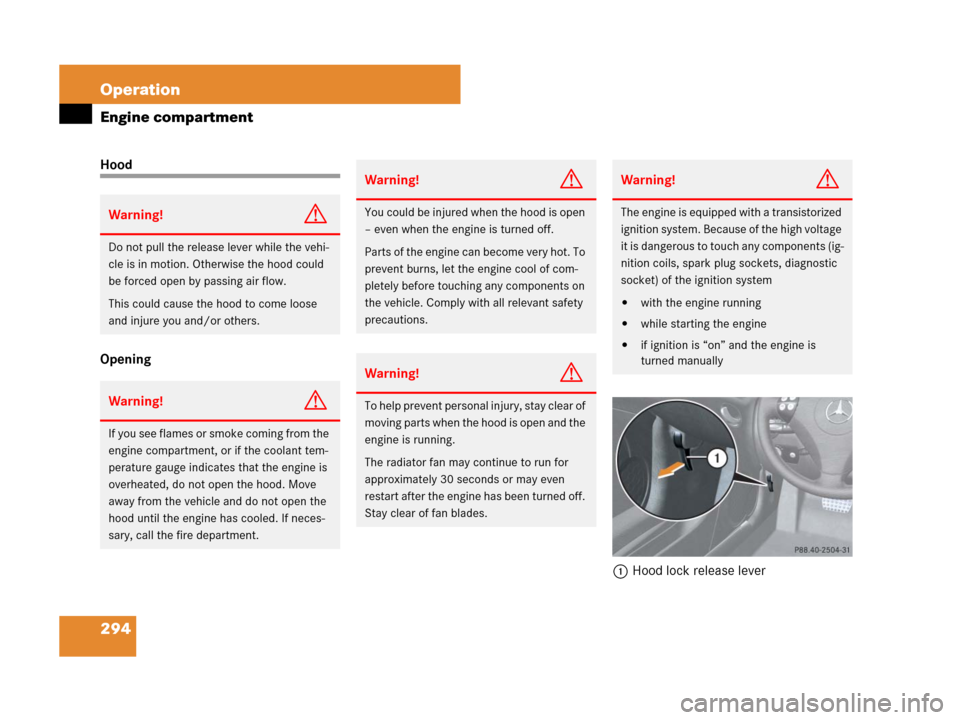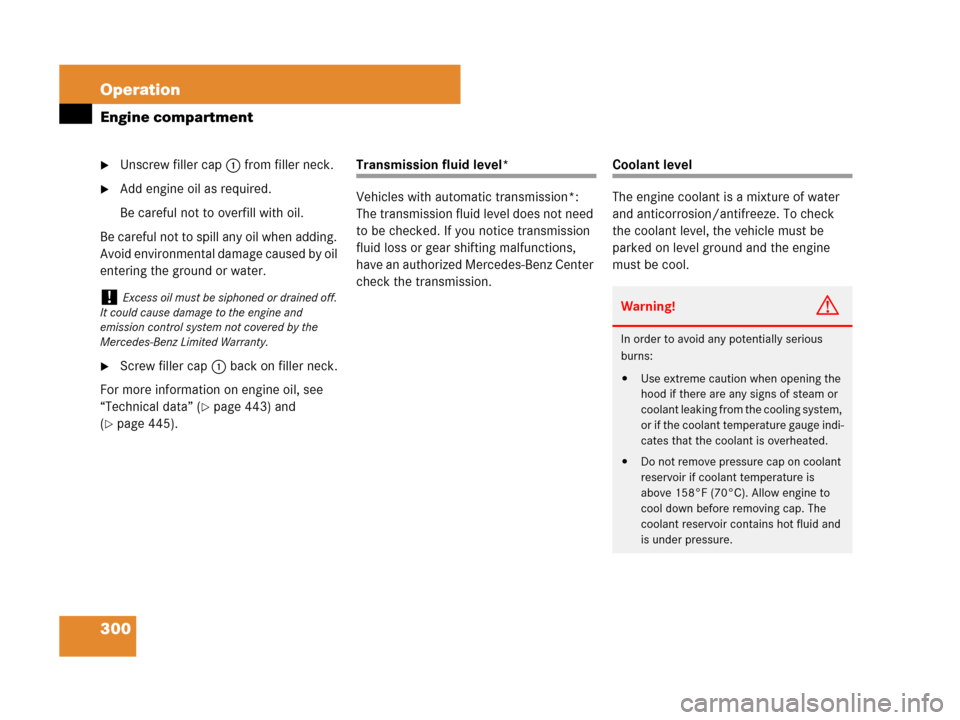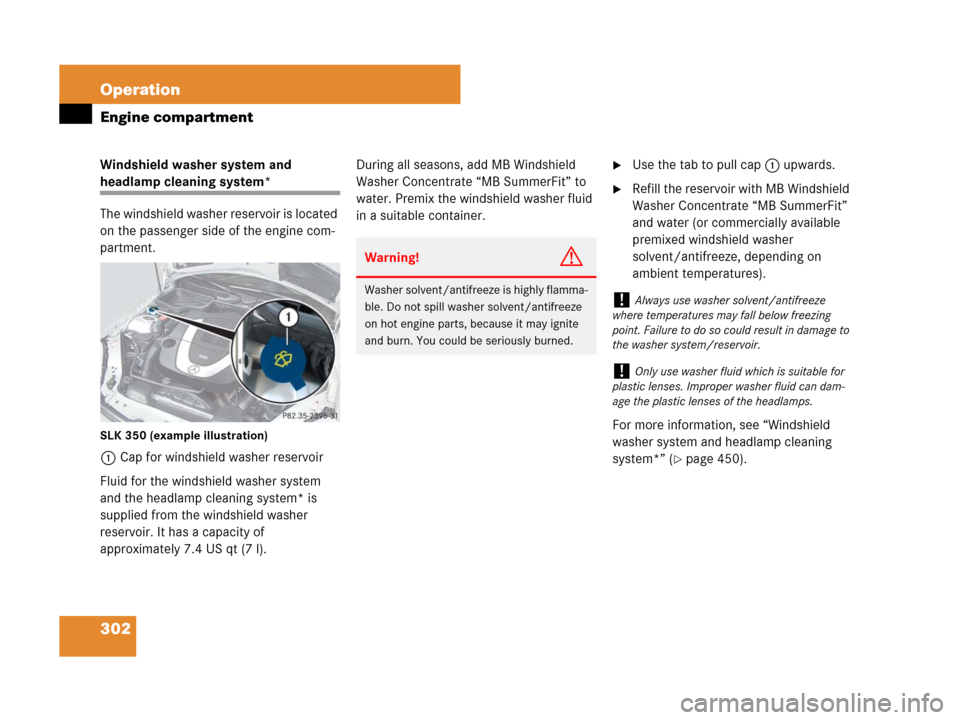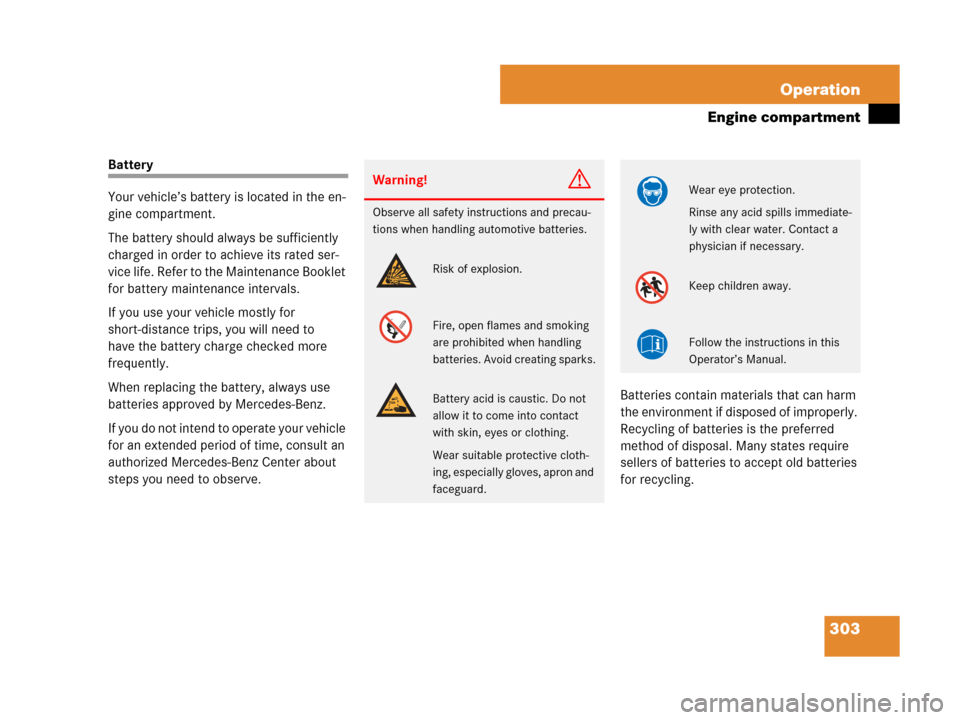Page 291 of 473
290 Operation
Driving instructions
!Excessive coolant temperature triggers a
warning message in the multifunction display
(
�page 368).
The engine should not be operated with a
coolant temperature above 248°F (120°C).
Doing so may cause serious engine damage
which is not covered by the Mercedes-Benz
Limited Warranty.
iDuring severe operating conditions, e.g.
stop-and-go city traffic, the coolant temperature
may rise close to 248°F (120°C).
Page 292 of 473

291 Operation
At the gas station
�At the gas station
Refueling
The fuel filler flap is located on the
right-hand side of the vehicle towards the
rear.
Locking and unlocking the vehicle with the
SmartKey automatically locks and unlocks
the fuel filler flap.1To open fuel filler flap
2To insert fuel filler cap
�Remove the SmartKey from the starter
switch.
�Open fuel filler flap by pushing at point
indicated by arrow1.
The fuel filler flap springs open.
�Turn fuel filler cap counterclockwise
and hold on to it until possible pressure
is released.
�Take off fuel filler cap and set it in
direction of arrow2 in the recess on
the inside of fuel filler flap.
To prevent fuel vapors from escaping
into open air, fully insert filler nozzle
unit.
�Only fill your tank until the filler nozzle
unit cuts out – do not top off or
overfill.
�Replace the fuel filler cap by turning it
clockwise until it audibly engages.
Warning!G
Gasoline is highly flammable and poisonous.
It burns violently and can cause serious
personal injury.
Never allow sparks, flame or smoking mate-
rials near gasoline!
Turn off the engine before refueling.
Whenever you are around gasoline, avoid
inhaling fumes and skin contact, extinguish
all smoking materials.
Direct skin contact with fuels and the
inhalation of fuel vapors are damaging to
your health.
iIn case that the central locking system does
not release the fuel filler flap, or the opening
mechanism is clamping, contact Roadside
Assistance or an authorized Mercedes-Benz
Center.
Warning!G
Overfilling of the fuel tank may create pres-
sure in the system which could cause a gas
discharge. This could cause the gas to spray
back out when removing the fuel pump noz-
zle, which could cause personal injury.
��
Page 293 of 473

292 Operation
At the gas station
�Close the fuel filler flap.
Check regularly and before a long trip
Engine compartment
(example illustration, SLK 350)
1Windshield washer system and head-
lamp cleaning system* reservoir
2Brake fluid reservoir
3Coolant expansion tankWindshield washer system and head-
lamp cleaning system*
For information on refilling the reservoir,
see “Windshield washer system and
headlamp cleaning system*”
(
�page 302).
Brake fluid
For information on brake fluid, see “Fuels,
coolants, lubricants, etc.” (
�page 443).
iMake sure to close the fuel filler flap before
locking your vehicle as the flap locking pin
prevents closing after you have locked the
vehicle.
iOnly use premium unleaded gasoline with a
minimum Posted Octane Rating of 91 (average
of 96 RON/86 MON).
Information on gasoline quality can normally be
found on the fuel pump. Please contact gas
station personnel in case labels on the pump
cannot be found.
For more information on gasoline, see “Premium
unleaded gasoline” (
�page 446), refer to the
Factory Approved Service Products pamphlet
(USA only), or contact an authorized
Mercedes-Benz-Center.
iLeaving the engine running and the fuel cap
open can cause the yellow fuel tank reserve
warning lamp to flash and the?malfunction
indicator lamp (USA only) or the
±malfunction indicator lamp (Canada only)
to illuminate.
For more information, see “Practical hints”
(
�page 349).
iFor opening the hood, see “Hood”
(
�page 294).
!If you find that the brake fluid in the brake
fluid reservoir has fallen to the minimum mark or
below, have the brake system checked for brake
pad thickness and leaks immediately. Notify an
authorized Mercedes-Benz Center immediately.
Do not add brake fluid as this will not solve the
problem.
For more information, see “Practical hints”
(
�page 348).
��
Page 295 of 473

294 Operation
Engine compartment
Hood
Opening
1Hood lock release lever
Warning!G
Do not pull the release lever while the vehi-
cle is in motion. Otherwise the hood could
be forced open by passing air flow.
This could cause the hood to come loose
and injure you and/or others.
Warning!G
If you see flames or smoke coming from the
engine compartment, or if the coolant tem-
perature gauge indicates that the engine is
overheated, do not open the hood. Move
away from the vehicle and do not open the
hood until the engine has cooled. If neces-
sary, call the fire department.
Warning!G
You could be injured when the hood is open
– even when the engine is turned off.
Parts of the engine can become very hot. To
prevent burns, let the engine cool of com-
pletely before touching any components on
the vehicle. Comply with all relevant safety
precautions.
Warning!G
To help prevent personal injury, stay clear of
moving parts when the hood is open and the
engine is running.
The radiator fan may continue to run for
approximately 30 seconds or may even
restart after the engine has been turned off.
Stay clear of fan blades.
Warning!G
The engine is equipped with a transistorized
ignition system. Because of the high voltage
it is dangerous to touch any components (ig-
nition coils, spark plug sockets, diagnostic
socket) of the ignition system
�with the engine running
�while starting the engine
�if ignition is “on” and the engine is
turned manually
Page 296 of 473

295 Operation
Engine compartment
�Pull hood lock release lever1 in direc-
tion of arrow.
The hood is unlocked.
2Lever for opening the hood
�Push lever2 on the hood upward to
release hood.
�With the hood released, lift the hood by
lifting it at the front edge.
The hood will be automatically held
open at shoulder height by gas-filled
struts.
Closing�Let the hood drop from a height of
approximately 1 ft (30 cm).
The hood will lock audibly.
�Check to make sure the hood is fully
closed.
If you can raise the hood at a point
above the headlamps, then it is not
properly closed. Open it again and let it
drop with somewhat greater force.!To avoid damage to the windshield wipers or
hood, never open the hood if the wiper arms are
folded forward away from the windshield.
Warning!G
When closing the hood, use extreme caution
not to catch hand or fingers. Be careful that
you do not close the hood on anyone.
Make sure the hood is securely engaged be-
fore driving. Do not continue driving if the
hood can no longer engage after an accident
for example. The hood could otherwise
come loose while the vehicle is in motion
and injure you and/or others.
Page 301 of 473

300 Operation
Engine compartment
�Unscrew filler cap1 from filler neck.
�Add engine oil as required.
Be careful not to overfill with oil.
Be careful not to spill any oil when adding.
Avoid environmental damage caused by oil
entering the ground or water.
�Screw filler cap1 back on filler neck.
For more information on engine oil, see
“Technical data” (
�page 443) and
(
�page 445).
Transmission fluid level*
Vehicles with automatic transmission*:
The transmission fluid level does not need
to be checked. If you notice transmission
fluid loss or gear shifting malfunctions,
have an authorized Mercedes-Benz Center
check the transmission.Coolant level
The engine coolant is a mixture of water
and anticorrosion/antifreeze. To check
the coolant level, the vehicle must be
parked on level ground and the engine
must be cool.
!Excess oil must be siphoned or drained off.
It could cause damage to the engine and
emission control system not covered by the
Mercedes-Benz Limited Warranty.Warning!G
In order to avoid any potentially serious
burns:
�Use extreme caution when opening the
hood if there are any signs of steam or
coolant leaking from the cooling system,
or if the coolant temperature gauge indi-
cates that the coolant is overheated.
�Do not remove pressure cap on coolant
reservoir if coolant temperature is
above 158°F (70°C). Allow engine to
cool down before removing cap. The
coolant reservoir contains hot fluid and
is under pressure.
Page 303 of 473

302 Operation
Engine compartment
Windshield washer system and
headlamp cleaning system*
The windshield washer reservoir is located
on the passenger side of the engine com-
partment.
SLK 350 (example illustration)
1Cap for windshield washer reservoir
Fluid for the windshield washer system
and the headlamp cleaning system* is
supplied from the windshield washer
reservoir. It has a capacity of
approximately 7.4 US qt (7 l).During all seasons, add MB Windshield
Washer Concentrate “MB SummerFit” to
water. Premix the windshield washer fluid
in a suitable container.
�Use the tab to pull cap 1 upwards.
�Refill the reservoir with MB Windshield
Washer Concentrate “MB SummerFit”
and water (or commercially available
premixed windshield washer
solvent/antifreeze, depending on
ambient temperatures).
For more information, see “Windshield
washer system and headlamp cleaning
system*” (
�page 450).
Warning!G
Washer solvent/antifreeze is highly flamma-
ble. Do not spill washer solvent/antifreeze
on hot engine parts, because it may ignite
and burn. You could be seriously burned.!Always use washer solvent/antifreeze
where temperatures may fall below freezing
point. Failure to do so could result in damage to
the washer system/reservoir.
!Only use washer fluid which is suitable for
plastic lenses. Improper washer fluid can dam-
age the plastic lenses of the headlamps.
Page 304 of 473

303 Operation
Engine compartment
Battery
Your vehicle’s battery is located in the en-
gine compartment.
The battery should always be sufficiently
charged in order to achieve its rated ser-
vice life. Refer to the Maintenance Booklet
for battery maintenance intervals.
If you use your vehicle mostly for
short-distance trips, you will need to
have the battery charge checked more
frequently.
When replacing the battery, always use
batteries approved by Mercedes-Benz.
If you do not intend to operate your vehicle
for an extended period of time, consult an
authorized Mercedes-Benz Center about
steps you need to observe.Batteries contain materials that can harm
the environment if disposed of improperly.
Recycling of batteries is the preferred
method of disposal. Many states require
sellers of batteries to accept old batteries
for recycling.
Warning!G
Observe all safety instructions and precau-
tions when handling automotive batteries.
Risk of explosion.
Fire, open flames and smoking
are prohibited when handling
batteries. Avoid creating sparks.
Battery acid is caustic. Do not
allow it to come into contact
with skin, eyes or clothing.
Wear suitable protective cloth-
ing, especially gloves, apron and
faceguard.
Wear eye protection.
Rinse any acid spills immediate-
ly with clear water. Contact a
physician if necessary.
Keep children away.
Follow the instructions in this
Operator’s Manual.